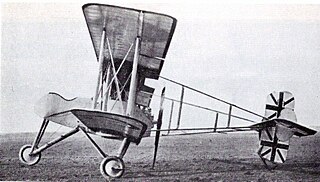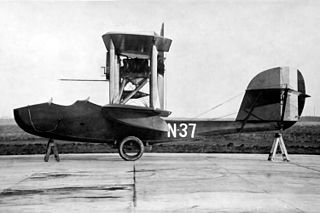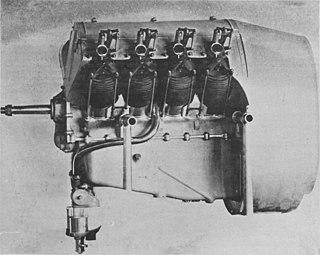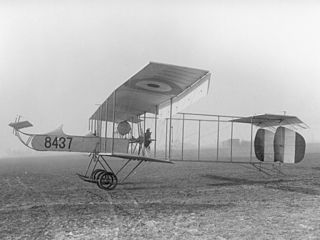
The Fairey Aviation Company Fairey III was a family of British reconnaissance biplanes that enjoyed a very long production and service history in both landplane and seaplane variants. First flying on 14 September 1917, examples were still in use during the Second World War.

The Maurice Farman MF.11 Shorthorn is a French aircraft developed before World War I by the Farman Aviation Works. It was used as a reconnaissance and light bomber during the early part of World War I, later being relegated to training duties.
The Pemberton-Billing P.B.25 was a First World War British single-seat scout aircraft built by Pemberton-Billing Limited, later Supermarine Aviation Works Limited.

The Bréguet Bre.4, also known variously as the Type IV and BUM, was a French biplane bomber of World War I. A fighter version of it was also produced as the BUC and BLC; some of these saw service with the British Royal Navy, which called them 'the Bréguet 'de Chasse.

The Bréguet Bre.V B.2 bomber and Bréguet Bre.V Ca.2 escort fighter were French biplanes of World War I which were developments of the Bréguet Bre.IV bomber. The Bre.VI and Bre.XII were, in turn, developments of the Bre.V

The Norman Thompson N.T.4 was a twin-engined British flying boat of the First World War. Although less well known than similar Curtiss and Felixstowe flying boats, 50 were ordered for Britain's Royal Naval Air Service.
The Sopwith Admiralty Type 807 was a 1910s British biplane seaplane designed and built for the Admiralty by the Sopwith Aviation Company.
The Sopwith Two-Seat Scout was a 1910s British biplane Anti-Zeppelin scout biplane designed and built for the Admiralty by the Sopwith Aviation Company. It was nicknamed the Spinning Jenny due to a tendency to enter a spin.
The Wight Twin was a British large twin-engined aircraft of the First World War. It was a twin-engined, twin boom biplane. One was built as a landplane for France, while three more similar aircraft were built as Seaplanes for the British Royal Naval Air Service. Both versions were unsuccessful and saw no service.

The Norman Thompson N.T.2B was a British single-engined flying boat trainer of the First World War. A single-engined biplane, the N.T.2B was adopted as a standard flying boat trainer by the Royal Naval Air Service, training pilots for larger patrol flying boats such as the Felixstowe F.2.

The White and Thompson No. 3 was a British flying boat of the First World War. While the prototype was originally designed to compete in an air-race around the UK, eight more similar aircraft were built for the Royal Naval Air Service.

The Norman Thompson N.1B was a prototype British flying boat fighter aircraft of the First World War. A two-seat single-engined pusher biplane, a single example was built in 1917, but no production followed.
The Sopwith Three-seater was a British aircraft designed and built prior to the start of the First World War. One of the first aircraft built by the Sopwith Aviation Company, it was operated by both the Royal Naval Air Service (RNAS) and the Royal Flying Corps (RFC), being used briefly over Belgium by the RNAS following the start of the War.

The Renault 70 hp or Type WB was a French V-8 aero engine that first ran circa 1907. It was also manufactured under license by Renault Limited of West Brompton, London between August 1914 and December 1918, three other companies, including Rolls-Royce, also produced the engine. A variant known as the Type WC used an external oil pump as opposed to the internal pump of the Type WB. The Renault V-8 engines were noted as inefficient but reliable, the inefficiency being mainly due to the excessively rich fuel/air mixture used to assist cooling.

The Royal Aircraft Factory H.R.E.2 was intended as a Naval reconnaissance floatplane. The single example built was serving with the Royal Naval Air Service at the start of World War I.

The White & Thompson No. 1 Seaplane was the first British built twin-engined biplane flying boat, assembled just prior to the outbreak of the First World War to compete in an air-race around the UK. It was unsuccessful, only the single prototype being built.
The Norman Thompson Flight Company was a British aircraft manufacturer specialising in the construction of flying boats. It was formed as the White and Thompson Company in 1912, and designed and built the Norman Thompson NT.4 patrol aircraft and the N.T.2B flying boat trainer for the Royal Naval Air Service during the First World War, but production problems led to the company entering receivership in 1918, being liquidated in 1919.

The Short S.38 was an early British aircraft built by Short Brothers.
The Dyott Bomber was a prototype twin-engined British biplane bomber aircraft of the First World War. Two examples were built but the type was not adopted for service.













